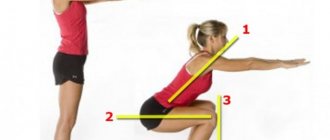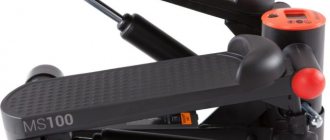It’s hard to think of a more useful tool than a bicycle, not only for walking and moving around, but also as a means of getting your health in order. The cardiovascular system, musculoskeletal system, vestibular system and even the organs of vision improve. Cycling is also indispensable if you want to lose weight. But not everything is so simple: not every trip leads to intense calorie burning. To do this, a number of conditions must be met. This article talks about how many calories are burned when riding a bike, and how you should ride a bike to lose weight as much as possible. Of course, healthy cycling trips are so much fun! Cycling has many health benefits. Here are just the most important ones:
- A bicycle, increasing the body weight of an adult man by only 20%, is capable of simultaneously increasing his speed of movement without much energy consumption by half (from 6 to 12 km/h), and with intense load - by 3-4 times. In terms of this ratio, no vehicle could surpass the bicycle.
- A bicycle is an absolutely environmentally friendly vehicle.
- The bike is absolutely silent. This is important on country trips.
- The bike is easy to maintain and can be easily repaired while on the road.
- When riding a bicycle, especially on rough terrain, the adrenaline production and pleasure of riding are significantly superior to those when running.
- With the help of a bicycle, you can discover new trails, create new routes and maps, always feel like a pioneer, and for people who love solitude and silence, a bike allows them to be alone with nature.
Compare the freedom of cycling with a fitness room or “rocking chair” crowded with people, when at any time you need to “not miss” an empty exercise machine: But the bicycle at the end of the 20th and beginning of the 21st century became almost perfect, so its disadvantages are a continuation of its advantages . It is precisely because of the efficiency of a bicycle relative to pedestrian movement that calorie consumption is not as high as we would like. How many calories does cycling burn? So, for example, if we take distance as a basis, a pedestrian can walk 5-6 km in an hour, and a cyclist can cover a similar section of path on a flat road in 25-30 minutes and spend much less calories. If we take time as a basis, then in an hour's ride a cyclist can burn more calories than a pedestrian, or maybe less, because the road can sometimes go downhill. Even if the road is absolutely flat, the cyclist sits and the pedestrian walks. But every cloud has a silver lining. Burning calories on a bicycle is “long-lasting.” It starts slowly, but continues several hours after the end of the walk.
How to lose weight by cycling
Cycling burns 50% more calories than the simplest and most accessible activity - walking. This is suitable for those people who do not have a lot of time for walking.
Cycling can be fit into your work schedule much more successfully than running. Getting to work by bike will be faster, and you can take a backpack of any size with you that will fit everything you need. Also, when cycling calmly, sweating is not as profuse, so the issue of showering at work is less relevant.
Cycling is not a chore and can easily turn into a multi-hour activity. This means burning more calories per workout.
At the same time, the musculoskeletal system will not be subjected to such stress as when running, so cycling is suitable for most people. Brisk walking and running can be difficult for overweight people with arthritis, while cycling reduces pressure on joints.
Source: triradar.com
But don't forget that all weight loss comes down to a simple truth: if you burn more calories than you consume, you will lose weight. This is why exercising can be a huge help when trying to lose weight. They help you achieve a calorie deficit without eating only lettuce leaves.
So which is better?
In this case, the choice should be made based on your personal preferences and feelings. It is more difficult to learn to ride on roller skates than on a bicycle, but they slightly outweigh the bicycle in terms of benefits for the body, only for the reason that more muscles are used while riding them.
However, in terms of the number of calories burned and the effect on the body, especially the heart, these types of transport are almost the same. You can safely come to a sports store and choose what you like, knowing that your body will definitely thank you.
How many calories are burned in an hour's drive?
Using online calorie calculators may give incorrect estimates. Discrepancies can sometimes be as much as 20%. Unlike runners, whose energy expenditure is easier to predict, cyclists are subject to a number of variables. The first and most important thing is that on a bicycle we can coast and ride downhill without any effort at all.
Training plans for marathon and half marathon. and start preparing today.
The next most important factor is aerodynamics, not just wind direction or speed. The larger the frontal surface area, the greater the aerodynamic drag. If you have a large frame, an upright stance and flowing clothes, you will need more energy to simply cut through the air than a skinny racer in tight Lycra.
Suppose three cyclists weighing 55 kg, 75 kg and 90 kg ride along the plain at the same speed. How will their energy expenditure differ?
21 km/h
- 55 kg – 440 kcal/h
- 75 kg – 600 kcal/h
- 90 kg – 720 kcal/h
24 km/h
- 55 kg – 550 kcal/h
- 75 kg – 750 kcal/h
- 90 kg – 900 kcal/h
29 km/h
- 55 kg – 660 kcal/h
- 75 kg – 900 kcal/h
- 90 kg – 1080 kcal/h
The formula based on height and speed is the most inaccurate, because the variables of a person’s physical form, route, and equipment are left out. All this adds up to the 20% error.
Is an exercise bike effective for burning calories?
Believe me! If a calorie-burning exercise bike could talk, he would ask exactly the same question to someone who is about to start training on it.
There is only a bit of humor and gentle irony in this statement, because we, the creators and organizers of one of the most popular online discounters of sports equipment in Russia, often have to deal with dissatisfied customers.
No no. We offer only serviceable and proven equipment from well-known domestic and foreign manufacturers. But here's the thing: the exercise bike burns your calories in direct proportion to:
- the degree of your efforts that you make during classes on it;
- intensity of the lesson;
- the speed of metabolic processes that are invisibly carried out in your body, beyond your control;
- a diet that you can, depending on your desire and capabilities, either follow or not follow (yes, the hearty breakfast or lunch that you ate before starting classes also determines exactly how many kcal are burned on the exercise bike).
Someone who leisurely pedals in the “lightest” workout mode, looking at the clock or out the window, and enjoying life, is unlikely to burn more than 250 kcal per hour on the coolest exercise bike.
Well, a person who spins an old “belt” or “block” exercise bike as hard as he can can lose 850 kcal. And it is not at all a fact that he will be right, because the level of permissible load is a completely separate topic that should be discussed not so much with the specialists of our sports discounter, but with a personal therapist or a specialized medical specialist involved in the treatment of an existing chronic disease. So!
Which cycling workouts burn more calories?
To optimize your trips and burn as many calories as possible, use our tips.
Take long, moderate-intensity rides
Doing short, high-intensity interval training burns a lot of calories in a short period of time. However, not everyone can perform such sessions, and there is no need to do such training too often.
For interval training on a bicycle, 2-3 times a week is enough.
The good news is that long, moderate-intensity workouts (when your heart rate is at 80% of your maximum) are also effective at burning calories, and can be done more frequently without much risk of injury.
Reduce coasting
When you roll down a slope, your body works with less effort. This is the main reason why athletes burn more calories when running. Therefore, try to coast as little as possible.
Only if you have previously worked well on the climb, then, of course, you deserve a rest on the descent.
Ride rough terrain
Driving on unpaved surfaces requires more energy than on smooth asphalt. A mountain bike ride can burn up to 100 calories more than the same amount of time on the road.
Ride in a group
It can be difficult to find the motivation to go out for a workout or to pick up a faster pace than usual. But when you are riding in a strong group, there is practically no chance of coasting. As a result, you will put in more effort than usual, your heart rate will begin to rise, and the number of calories burned will increase every minute.
Another advantage of group training is that you are unlikely to miss it, knowing that your comrades are waiting for you.
Do different workouts
The body somehow adapts to the load, so it is necessary to regularly change the types of training. Don't focus on the same intensity and the same length of intervals.
Choose a hilly route
There is nothing easier to increase your heart rate than going uphill. Even if you don’t climb as hard as you can, your heart rate will still increase.
Source: usacycling.org Photo: Casey Gibson
In the world of cycling, where riders are trying to save energy, there is a common belief that sitting in the saddle is preferable. But for those who want to spend this energy, it is recommended to get out of the saddle. This way you use more muscles.
The effect of age and heart rate on the number of calories burned
It is very important to be aware of your maximum possible heart rate when starting training. As you get older, you will notice that your maximum heart rate level gradually decreases with age.
In order to calculate your approximate maximum heart rate, you need to subtract your age from 220. That is, if you are 40, your maximum heart rate is 220 -40 = 180 beats per minute. This number is affected by age, meaning as you get older, your heart can't beat too fast.
“The average person’s resting heart rate is between 60 and 100 beats per minute, and this number remains in this range throughout life.”
Anaerobic exercises are exercises in which you subject your body to high-intensity exercise in a short period of time, which utilizes the energy sources from your muscles to a greater extent.
Aerobic exercises are the exact opposite of anaerobic exercises; they are performed for longer periods of time and involve large muscle groups. By doing aerobic exercise, you train your heart and cardiovascular system, thereby helping to increase the rate of oxygen delivery to every cell of the body.
It is impossible to measure your heart rate using all kinds of online calculators, however, you can monitor it using a fitness bracelet or smart watch.
Formula for calorie consumption when cycling
A cyclist weighing 90kg may be in better shape than his fellow cyclist weighing 75kg. Then driving at a speed of 29 km/h for the first will not be as intense as for the second. And here we come to the fact that for a more accurate calculation of calories we lack a pulse sensor.
So, the first cyclist can ride 29 km/h in the second intensity zone, while the second, who is not in the best physical shape, will be in the medium or high zone. Of course, the second person will spend more calories per hour relative to his weight.
If you use a heart rate monitor, there will be an error, of course, but not so much. Most likely, your watch, synced to your heart rate sensor, uses this formula:
Energy consumption (kcal) = 0.014 * M * t * (0.12 * P – 7), where M is the person’s body weight, t is the time of the race, P is the average heart rate during the race.
How does speed affect energy costs?
The faster you go, the more distance you can cover in a shorter time. However, if you're on a group ride and someone covers the same distance as you but at a slower speed, that doesn't mean you burned more calories.
If a person weighs the most in the group, then perhaps he will expend the most energy among the participants, even if he finishes later. In general, if you are limited in time, the following pattern is true: the faster you move, the more energy you will expend.
It follows from this that if, with your own weight of 80 kg, you devoted an hour to cycling, and your speed was 16 km/h, then you will spend 567 calories (and, accordingly, cover a distance of 16 km).
Calculating an effective training schedule
Combining the knowledge gained above, let's do a little calculation. For example, let's take a 40-year-old person with a body weight of 120 kg and a height of 192 cm. According to ideal weight calculations, the desired body weight is 90 kg. The excess weight is 30 kg.
It is this weight that we will try to burn through cycling. We multiply 30,000 grams by 9, we get 270,000 kilocalories. Considering that with a moderate load, 270 kcal are consumed for an average weight of 70 kg, we get the figure of 350 kcal for our conditional weight of 120 kg. That is, with a 120-minute workout at a walking pace, you will burn about 700 kcal. It is unlikely that an amateur will ride for more than 2 hours.
Therefore, when dividing 270,000 kilocalories by 700, we get 385 two-hour workouts. This is exactly how many walks we need to burn off 30 kilograms of excess weight.
Of course, with a strict diet and intense training, the weight will burn faster, however, the stress on the body will be greater. To increase the effectiveness of your training, be sure to make friends with proper nutrition! After training, give preference to fruits and vegetables, greens and whole grain cereals.
If you are an experienced cyclist with a high level of training, our second calculation based on the same parameters may be useful to you. To achieve the desired effect, it will be enough to go on a 96-day cycling trip with 8-hour daily treks.
The terrain and type of bike also affect the effectiveness of the training.
When choosing a bike for weight loss, you need to take into account your temperament and riding style. If you prefer to ride on roads with good surfaces, then you need to immediately count on long training sessions, since when riding there will be less variety in the load on the muscles than in the case of mountain biking.
A mountain bike will allow you to race along forest paths, effortlessly climb steep climbs and, what is especially valuable, stand up and “screw in” the pedals while climbing. This change in the pace of work and breathing during the race leads to improved blood supply to the muscles and an increase in the effect of the workout. But, in any case, the bike must be multi-speed.
Below, in descending order of calories burned, are the different types of cycling workouts:
- Riding a mountain bike
- Driving on the highway
- Riding on bike paths
- Exercise bike training
On a mountain bike or cross-country, you expend maximum energy due to greater physical activity. The track ride takes second place, as the route is smoother, but it is possible to change the level of incline.
Riding on bike paths is even more difficult in terms of weight loss compared to mountain biking, since all the paths do not have any obstacles and are usually quite smooth. Working out on an exercise bike is convenient because you can fine-tune both the angle of the climb and the force on the connecting rods.
Which is the best route?
The answer is simple - the best route is the one you like, since such training will be easier for you to do regularly. Losing weight is only possible with constant exercise.
If you are focused on fat burning, then from this point of view, the best choice would, of course, be trips in the mountains and over rough terrain due to the higher intensity of the load. On the other hand, it may be easier for you to regularly organize races on the highway than in the mountains.
And of course, it’s easier to do workouts that you get more pleasure from. The key factors in fat burning are:
- Eating immediately after training;
- Various lengths of races;
- Applying due effort to classes;
- Carrying out joint bike races;
- Regularity.
Useful information about walking and cycling
Walking is the easiest way to be physically active . It does not require special facilities and equipment, or the purchase of expensive clothing and shoes. You can work out on your own and at a convenient time, and not when the desired trainer or gym is free. In addition, you can start and finish right at your home. Another advantage is that walking is a natural need of the body . She does not need to be trained, she does not require special effort and effort. Every person has been able to do everything that needs to be done since childhood and does it without thinking, “automatically.”
When walking, all muscle groups and joints work harmoniously . Of course, the lower part of the body is most loaded, but the spine and abs are also involved. The hands are least involved in the movement. Although, if desired, you can switch to other types of walking, in which the upper limbs are more involved in the movement. For example, for sports or Scandinavian. Doctors assure that to satisfy physical “hunger”, ideally you need to walk every day for at least an hour, covering 5-6 kilometers.
A bicycle is the most affordable, economical and environmentally friendly wheeled vehicle. It does not “eat” fuel and does not “spew” harmful emissions into the air. But when using it you need:
- Choose the right bike and saddle height, saddle angle and proximity to the handlebars.
- Choose a convenient design and length of the frame and steering wheel.









